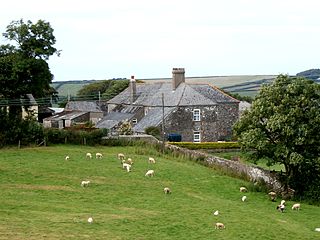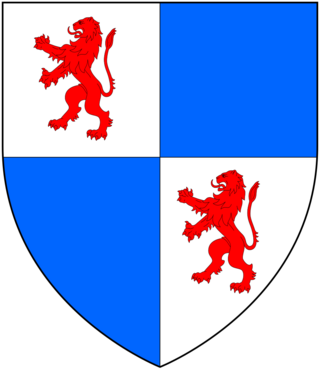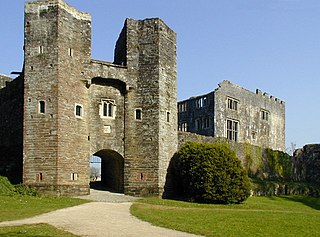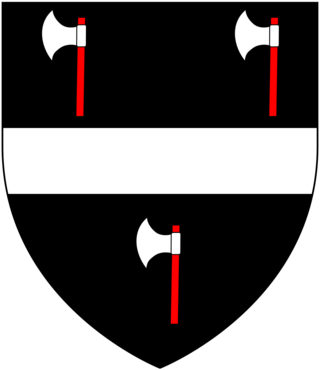William Elford | |
|---|---|
 | |
| Born | August 1749 |
| Died | 30 November 1837 |
| Occupation | Politician |
| Branch | British Army |
Sir William Elford, 1st Baronet (August 1749 – 30 November 1837) was an English banker, politician, and amateur artist.
William Elford | |
|---|---|
 | |
| Born | August 1749 |
| Died | 30 November 1837 |
| Occupation | Politician |
| Branch | British Army |
Sir William Elford, 1st Baronet (August 1749 – 30 November 1837) was an English banker, politician, and amateur artist.
William Elford of Bickham, Buckland Monachorum, Devon, was the elder son of the Reverend Lancelot Elford, of Bickham, and Grace, daughter of Alexander Wills of Kingsbridge, Devonshire. His family was one of the oldest in the west of England.
Elford was a partner in the banking firm at Plymouth of Elford, Tingcombe, & Clerk, and was connected in many capacities with the same town. He was Recorder of Plymouth from 1797 to February 1833 and was afterwards Recorder for Totnes from 1832 to 1834.
He was elected MP for Plymouth from 1796 to 1806, when he was defeated, bringing an unsuccessful petition against his antagonist, Sir C. M. Pole, Bart. He also represented Westbury for some time. In July 1807 he was elected M.P. for Rye, but resigned his seat in July 1808. He was lieutenant-colonel of the South Devon Militia, and in that capacity accompanied his regiment to Ireland during the Irish rebellion, 1798–9. On 29 November 1800 he was created a baronet, of Bickham in the County of Devon. [1]
Elford was a friend of William Pitt the Younger and frequently visited Bath, where he was noted as a whist-player and was acquainted with many of the leading literary characters and artists of his day. He possessed considerable scientific attainments, and in 1790 was elected a Fellow of the Royal Society and in 1813 the Linnaean Society. [2] A few years before his death he published the results of his investigations as to a substitute for common yeast, and his discoveries excited some attention.
Elford was also an artist of great excellence. He was a constant contributor to the Royal Academy exhibitions from 1774 to 1837, and his pictures were marked by great taste and good draughtsmanship. The last exhibited by him was painted in his eighty-ninth year. There are three wash drawings by him in the print room at the British Museum. His most important picture was 'The White Lady of Avenel', exhibited in 1822, and now in the possession of his grandson, Colonel Henry Cranstoun Adams of Lion House, Exmouth, and Crapstone, Buckland Monachorum. There is a landscape by Elford at Windsor Castle, which he presented to the Prince Regent in 1819, and he also presented pictures painted by himself to the University of Oxford and to many of his friends.
Elford was ruined when his bank failed in 1825 and after being forced to sell his Bickham estate lived the latter part of his life at the Priory, Totnes, the home of his son-in-law. He was twice married; his first wife was Mary, daughter and heiress of the Rev. John Davies of Plympton, who died in 1817, leaving one son, Jonathan Elford, who married and died in 1823 without issue, and two daughters, Grace Chard, died unmarried 24 Feb. 1856, and Elizabeth, who became the wife of General Sir George Pownoll Adams, K.C.H.; his second wife was Elizabeth, daughter of Humphrey Hall of Manadon, and widow of Lieutenant-colonel Walrond. He died at that place on 30 November 1837, aged 89, and was buried in the parish church, where there is a tablet to his memory. At Elford's death the baronetcy became extinct. James Northcote was an intimate friend of the Elford family, and painted numerous portraits of them, most of which, with others, are in the possession of the grandson, already mentioned, Colonel H. C. Adams, at Exmouth.
Elford was one of the primary correspondents of the writer Mary Mitford and their correspondence is compiled in two books by Rev. A.G. L'Estrange, The Friendships of Mary Russell Mitford published by Harper & Brothers, 1882, and The Life of Mary Russell Mitford, by the same publisher in 1870.

Tamerton Foliot is a village and former civil parish situated in the north of Plymouth, in the Plymouth district, in the ceremonial county of Devon, England. It also lends its name to the ecclesiastical parish of the same name.

Buckland Abbey is a Grade I listed 700-year-old house in Buckland Monachorum, near Yelverton, Devon, England, noted for its connection with Sir Richard Grenville the Younger and Sir Francis Drake. It is owned by the National Trust.

Halsbury is a historic manor in the parish of Parkham in North Devon, England. It is situated 2 miles north-east of the village of Parkham and 4 miles south-west of the town of Bideford. Halsbury was long a seat of the ancient Giffard family, a distant descendant of which was the celebrated lawyer Hardinge Stanley Giffard, 1st Earl of Halsbury (1823–1921), who adopted the name Halsbury for his earldom and was the author of the essential legal reference books Halsbury's Statutes. Halsbury Barton, now a farmhouse, retains 16th- and 17th-century elements of the former manor house of the Giffard family. It was described in a record of 1560 as a "new dwelling house".
Efford is an historic manor formerly in the parish of Eggbuckland, Devon, England. Today it has been absorbed by the city of Plymouth to become a large, mostly post-World War II, eastern suburb of the city. It stands on high ground approximately 300 feet above the Laira estuary of the River Plym and provides views over long distances: to the north across Dartmoor, to the east and south-east across the South Hams. It consists predominantly of local authority and housing association properties. Before this land was built upon it was known as 'The Wilds of Efford', and was largely unspoilt countryside and marsh land. That a deer park may have been attached to the manor is suggested by the survival of the street name "Deer Park Drive".

Sir Edward Seymour, 1st Baronet of Berry Pomeroy, Devon, was Member of Parliament for Devon, twice High Sheriff of Devon and an Army Colonel.

Sir Henry Pollexfen of Nutwell in the parish of Woodbury, Devon, was Lord Chief Justice of the Common Pleas.

John Pollexfen (1636–1715), of Walbrooke House in the parish of St Stephen Walbrook, City of London and of Wembury House in Devon, was a merchant, a courtier to Kings Charles II and William III, and a political economist who served four times as a Member of Parliament for Plympton Erle in Devon, in 1679, 1681, 1689 and 1690. He was opposed to the monopoly of the East India Company.

Sir Edward Seymour, 3rd Baronet of Berry Pomeroy Castle was an English politician who sat in the House of Commons at various times between 1640 and 1688. He fought for the Royalist cause in the English Civil War.

Sir Edward Seymour, 2nd Baronet was an English landowner and politician who sat in the House of Commons between 1601 and 1625. He was an ambassador to Denmark. During the English Civil War, he supported the Royalist cause.
Sir Francis Drake, 1st Baronet was an English politician who sat in the House of Commons in two parliaments between 1625 and 1629.

Sir John Fowell, 2nd Baronet of Fowelscombe in the parish of Ugborough in Devon, was thrice elected a Member of Parliament for Ashburton in Devon, between 1659 and 1677. He fought in the Parliamentary army during the Civil War and following the Restoration of the Monarchy was appointed in 1666 by King Charles II Vice-Admiral of Devon.

Sir William Strode (1562–1637) of Newnham in the parish of Plympton St Mary, Devon, England, was a member of the Devon landed gentry, a military engineer and seven times a Member of Parliament elected for Devon in 1597 and 1624, for Plympton Erle in 1601, 1604, 1621 and 1625, and for Plymouth in 1614. He was High Sheriff of Devon from 1593 to 1594 and was knighted in 1598. In 1599 he was appointed Deputy Lieutenant of Devon. There is a monument to him in the parish church of Plympton St Mary.

Sir Francis Drake, 3rd Baronet (1642–1718), of Buckland Abbey in the parish of Buckland Monachorum and of Meavy, both in Devon, England, was elected seven times as a Member of Parliament for Tavistock in Devon, in 1673, 1679, 1681, 1689, 1690, 1696 and 1698.

Forde House, now known as Old Forde House, is a Grade I listed former manor house dating in back to c. 1550 in Newton Abbot, Devon, England. The building was substantially enlarged c. 1610 and is noted for its fine 17th-century wood-carving and plasterwork. Once the manor house of the parish of Wolborough, it is now absorbed into a suburb of Newton Abbot. The south front faces Torquay Road across the house's front lawn. The building was purchased in 1978 by Teignbridge District Council which then built itself a modern headquarters in the grounds which opened in 1987. The council offices now take the name Forde House, and the old mansion is known as Old Forde House.

Nutwell in the parish of Woodbury on the south coast of Devon is a historic manor and the site of a Georgian neo-classical Grade II* listed mansion house known as Nutwell Court. The house is situated on the east bank of the estuary of the River Exe, on low-lying ground nearly contiguous to the water, and almost facing Powderham Castle similarly sited on the west bank. The manor was long held by the powerful Dynham family, which also held adjacent Lympstone, and was according to Risdon the site of their castle until John Dynham, 1st Baron Dynham (1433–1501), the last in the male line, converted it into "a fair and stately dwelling house".

Sir William Wrey, 1st Baronet of Trebeigh, St Ive, Cornwall and North Russell, Sourton, Devon, was High Sheriff of Cornwall in 1598 and was created a baronet by King Charles I in 1628.

Warleigh is an historic estate within the parish of Bickleigh in Devon, about 6 miles from Plymouth. Warleigh House, the manor house of the manor of Tamerton Foliot is situated one mile west of that village on the south-east bank of the River Tavy where it joins the River Tamar. It was remodelled in about 1830 in the Gothic style by John Foulston and has been listed Grade II* on the National Heritage List for England since 1960.
Lawrence Adams, of Totnes and Dartington, Devon, was an English politician.

Sherford is a village and former civil parish and manor, now in the parish of Frogmore and Sherford, in the South Hams district, in the county of Devon, England. It is situated about 2+1⁄2 miles (4 km) east of the town of Kingsbridge. It should not be confused with the new town Sherford to be built on the outskirts of Plymouth, about 18 miles (29 km) to the north-west. The parish church is dedicated to Saint Martin of Tours. In 1961 the parish had a population of 258. On 1 April 1986 the parish was abolished and merged with parts of South Pool and Charleton to form "Frogmore and Sherford". Sherford was recorded in the Domesday Book as Sireford/Sirefort/Sireforda.

Spridleston is an historic manor in the parish of Brixton in Devon, England, long a seat of a branch of the prominent and widespread Fortescue family. The ancient manor house does not survive, but it is believed to have occupied the site of the present Spriddlestone Barton, a small Georgian stuccoed house a few hundred yards from the larger Spriddlestone House, also a Georgian stuccoed house, both centred on the hamlet of Spriddlestone and near Higher Spriddlestone Farm.
![]() This article incorporates text from a publication now in the public domain : "Elford, William". Dictionary of National Biography . London: Smith, Elder & Co. 1885–1900.
This article incorporates text from a publication now in the public domain : "Elford, William". Dictionary of National Biography . London: Smith, Elder & Co. 1885–1900.